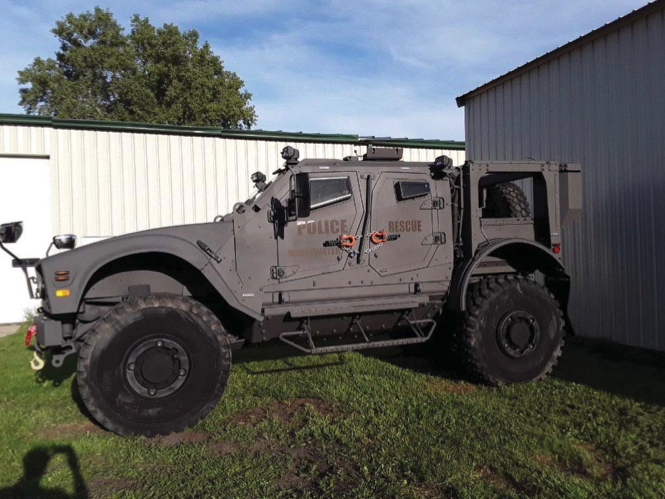By Kim McDarison
The Whitewater Common Council last Tuesday unanimously approved plans to transfer the city’s Mine Resistant Ambush Protected (MRAP) vehicle to another law enforcement agency or back to a military installation.
Offering information to council about changes made in the program through which the city obtained the vehicle, and after describing the pros and cons associated with keeping the vehicle, Whitewater Police Chief Dan Meyer said that while there was a usefulness for equipment like the MRAP vehicle, for his department, “the juice isn’t worth the squeeze on this one.”
He recommend transferring the vehicle to another agency.
He noted that a potential for the city to incur an expense of up to $10,000 was possible depending upon the process used to transfer the equipment by the government program through which it was received.
Changes in the program, options
Referencing a memo provided to council members in their meeting packet, Meyer noted that the MRAP vehicle was obtained by the Whitewater Police Department at no cost in July of 2019.
The vehicle was obtained through the U.S. Department of Defense Law Enforcement Support Office, or LESO, also known as the “1033 Program.”
The MRAP vehicle is the only piece of equipment obtained by the Whitewater Police Department through LESO, he said.
Meyer noted that all of the department’s personnel have been trained to operate the MRAP vehicle, which, he said, has been deployed by the department twice. The first time was in support of law enforcement operations during the 2020 riots in Kenosha, and a second time was during a situation in Whitewater, which, the memo noted, “involved a potentially barricaded suspect in possession of a firearm.”
Before new requirements were set by the program, use of the MRAP vehicle was not limited with regard to how it might be used by law enforcement, Meyer said.
He noted that new requirements going into effect as of Jan. 1, 2023, will change the way in which the vehicle can be deployed.
Within his memo to council, Meyer shared several requirements which he believed would impact the department and its use of the equipment, including:
• MRAP Updates: which noted that MRAP vehicles may now only be used for “disaster-related emergencies; active shooter scenarios, and hostage or other search and rescue operations or anti-terrorism preparedness, protection, prevention, response recovery or relief.” Search warrants are not included in the list of approved uses, Meyer wrote.
• Civilian Governing Body Approval: which noted that in order to participate in the LESO program, law enforcement agencies must receive annual approval from their Civilian Governing Board, which, within his memo, Meyer defined as the common council.
• Public Notice: which states that agencies must annually post public notice regarding the type of new controlled equipment the agency intends to requisition through the LESO program. Public notice must be made at least 30 days before the equipment is requisitioned through LESO.
• Training Requirements: which include requirements to provide scenario-based training to personnel that combines constitutional and community policing principles with controlled-property-specific training. The memo noted that those directed to use the controlled property should have enhanced scenario-based training to examine, deliberate, and review the circumstances in which the property should or should not be used.
Additionally, in his memo, Meyer offered several options that could be considered and approved by the council. They were:
• Sign the Defense Logistics Agency agreement enumerating the listed requirements which would allow the department to continue operations of the MRAP vehicle.
• Decline signing the agreement and work toward transferring the equipment to another location.
Meyer noted that, would the council approve plans to transfer the equipment to another agency, one of two processes could take place.
Once LESO was made aware that the department no longer wanted to maintain its MRAP vehicle, LESO would initiate a nationwide “data call,” looking for another agency that might like the equipment. Would another department become known, the Whitewater Police Department and that agency would work together to move the equipment and LESO would complete the required documentation.
In the event that another agency did not want the equipment, the Whitewater Police Department would become responsible for returning the MRAP vehicle to a specified military installation. A cost associated with the process could be as much as $10,000, Meyer said.
Meyer said he did not know which installation might be identified by the program to receive the equipment.
Council discussion
During discussion, Councilwoman Carol McCormick said: “When they delivered it, it was kind of like dumped on the city, wasn’t it?” She asked: “Were we expecting this piece of equipment?”
Meyer said that it was requested.
McCormick said it was her understanding that the city had “kind of tucked it away in the garage,” after, she said, a former city official said “it looked like we were going to be in combat or something.”
Meyer said he thought any misunderstanding about the equipment’s arrival was a “lack of communication.”
McCormick asked about the circumstances under which transferring the equipment might cost the city $10,000.
Meyer said the cost could potentially come if another law enforcement agency did not want the equipment and it needed to be returned to a military installation.
McCormick asked if Meyer knew which installation might be the closest.
Meyer said he did not know to where the program might send the vehicle. He did note that when it arrived in Whitewater, it was shipped from Texas.
Councilman Jim Allen suggested that Meyer might ask the National Guard if it would have an interest in receiving the vehicle.
Meyer said he agreed that might be an option, but, he added, such steps had not yet been taken. City staff had opted instead to bring the item before council for its input before taking any additional steps.
Allen suggested a military base nearby — perhaps Fort McCoy — might have interest in the vehicle.
Meyer agreed.
Councilwoman Brienne Brown asked: “If we decide to get rid of it, and find a better home for it, are we still able to participate in some of these programs for equipment that is a better fit for our community?”
Meyer said the city could still participate. He cited new requirements outlined in his memo, pointing specifically to two: approval to requisition the equipment from city council and the posting of a public notice.
Said Meyer: Essentially those two would need to be followed for any equipment that we request. So it’s not saying that if we give it (the MRAP vehicle) back we can never be a part of the LESO again. But realistically, there isn’t a — other than like night vision, things like that — there’s not a ton of equipment that’s all that useful for us.”
Councilwoman Jill Gerber focused on the cost of returning the vehicle as opposed to keeping it, citing the cost of annual training as the only cost to keeping the vehicle.
Meyer agreed that there was a cost associated with training, further citing costs associated with maintenance, fuel and other “small things.”
Additionally, he said, “I guess, a more implicit cost is potential liability if we are not training to a high enough standard and it’s used. There is liability there I believe as well. But, it wouldn’t be all that expensive to maintain it.”
Gerber asked Meyer to explain the city’s options if it wanted to return the vehicle using the data call, but then learned that no other law enforcement agency wanted the equipment. She asked if the city would have an option to keep the vehicle to avoid a $10,000 charge for its return to a military installation.
Further, she asked: “We do the data call, and let’s just say they come up with an agency out in California that wants it. Do you have to drive it half way, or does that pickup …?”
Said Meyer: “If that happens, I think we’d be on the phone with the LESO to figure out what the best course of action would be. We wouldn’t be driving it out no matter what. We would be putting it on a trailer and having it … “
Gerber asked: “Are we paying to deliver it half way there?”
Meyer said when the vehicle was received it was shipped. He did not believe the vehicle would be driven to a next destination.
Gerber asked about concerns with any potential deadlines that might preclude the city from making a different decision about keeping the vehicle. She stressed her desire to avoid a $10,000 cost.
Meyer said the city could opt to sign the agreement. At some point, he said, LESO would ask for its equipment back.
He said he didn’t know the specifics of when that would happen.
“So we can’t change our mind then?” Gerber asked.
Said Meyer: “Potentially. It really depends how on the ball this group is. I don’t know. And if there is a change in government at the highest level, this could completely go away, but, if it would wait until that point, I don’t know.”
Allen cited small expenditures that he recalled the police department incurring when the vehicle arrived, specifically noting “painting,” but, he said: “We don’t have a lot of expense into it, but I think we all pretty much felt that we didn’t want it anyway. So I don’t have any hard feelings seeing it go. I’d just like to see it go as inexpensively as possible of course.”
Allen asked if the police department might use the program to obtain drones with infrared capabilities.
Meyer said the city had access to drones with infrared capabilities through Walworth County and the town of Linn.
“A lot of the technology available through (the) 1033 (program) has already been through its useful life in the military. That’s why they are getting rid of it.” Meyer said.
With drones, he added: “If you are getting something that’s five years old, it’s really not all that useful anymore.”
Gerber asked from where the $10,000 might come if it would be required.
City Manager John Weidl said staff had not yet identified a source, but, he added, the city would not spend the money without coming back before council.
Finance Director Steve Hatton said: “It was not provisioned in our budget for this expense, so we would bring that back to the city council.”
The council unanimously voted to decline signing an agreement with the Defense Logistics Agency, opting to work towards moving the MRAP vehicle to another agency.


Two photos above: The city of Whitewater’s Mine Resistant Ambush Protected (MRAP) vehicle is parked near the city garage. The vehicle has been a part of the city’s emergency vehicle fleet since 2019. Changes in the program through which the vehicle was requisitioned and a lack of use were among reasons cited by Police Chief Dan Meyer for returning the vehicle to the U.S. Department of Defense Law Enforcement Support Office. The city council last Tuesday approved taking the required steps to offer the vehicle to another law enforcement agency. Contributed photos.
This post has already been read 1982 times!